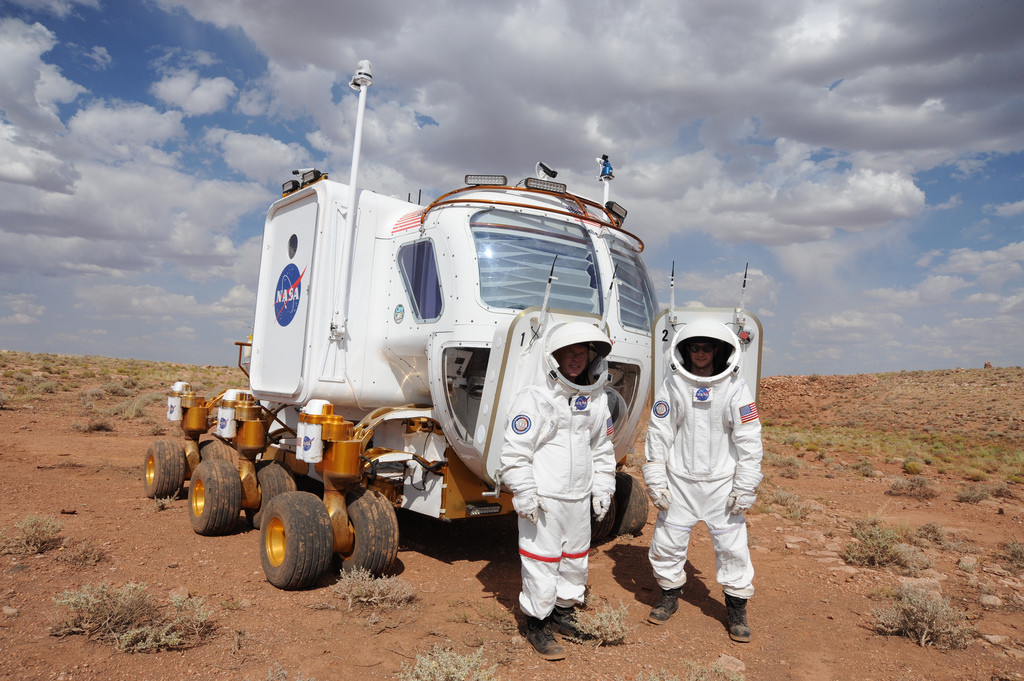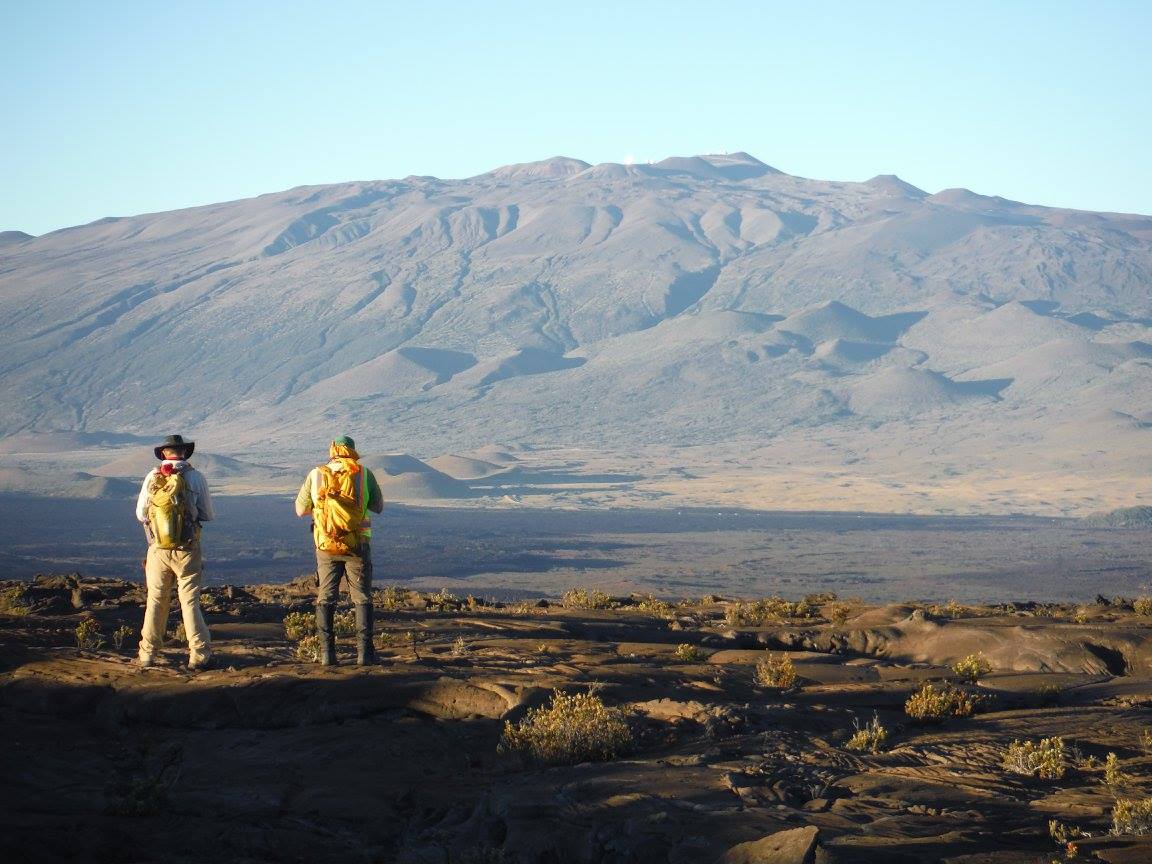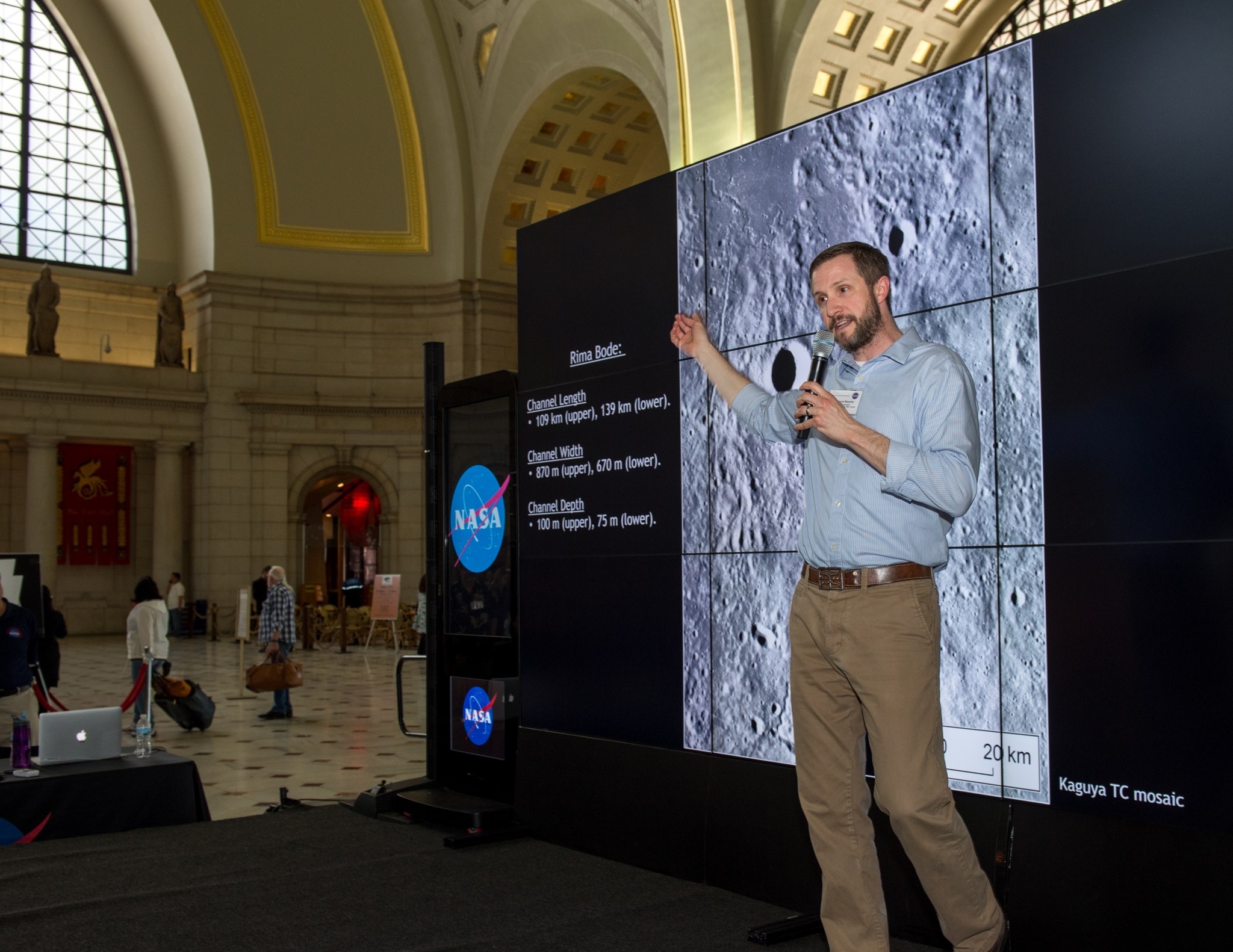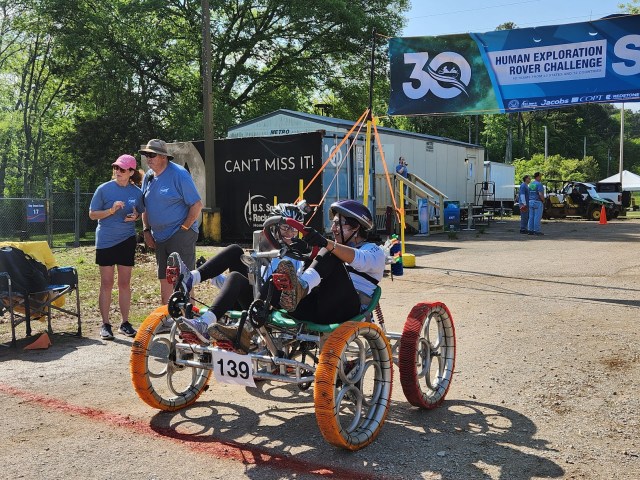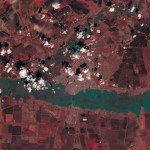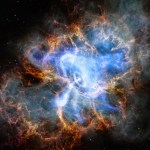Name: Jacob Bleacher
Title: Research Geologist and Lead Exploration Scientist for Goddard Strategic Collaborations
Formal Job Classification: Research Geophysicist
Organization: Code 698; Planetary Geology, Geophysics and Geochemistry Lab; Sciences Directorate
What do you do and what is most interesting about your role here at Goddard? How do you help support Goddard’s mission?
I am a research scientist. I specialize in volcanology, studies of volcanic terrains. I do both remote sensing and spacecraft data analysis for other planets, such as Mars, the Moon and asteroids. I try to understand the volcanic development of planetary surfaces and their modifications through time as a result of weathering or space interactions. To interpret these observations, I conduct fieldwork on the Earth on analog, or comparable, terrains. I am also an astronaut trainer for geosciences. I help prepare astronauts to observe the Earth from the International Space Station and to eventually conduct field geology on other planets. The combination of geoscience and geoscience training relate to Goddard’s effort to conduct fieldwork in support of instrument development for both science and human exploration.
What is your educational background?
I have a geology B.A. from Franklin and Marshall College in Pennsylvania and a Ph.D. in geological sciences from Arizona State University.
Please tell us about how you study the volcanic development of planetary surfaces and their modifications.
I study volcanic terrains on other planets to see how volcanoes erupted and how the lava flowed over time. My work ties into NASA’s overall objectives by helping understand potentially habitable environments through time.
For instance, active volcanoes provide energy at the surface and they are essentially atmosphere generators, always releasing gas. They have a huge impact on the surface environment and whether or not life could be sustained. Additionally, lava flows create structures, like lava tubes or caves that could protect native life or be a safe haven for explorers like astronauts.
I map lava flows and volcanoes on Earth and on other planets to try to piece the puzzle together. Here on Earth, I am able to conduct fieldwork to help confirm my remote sensing interpretations or lead to new interpretations, which helps us better interpret the volcanic history of other planets. We call this process ground truthing. Our volcanology work helps improve how Goddard develops instruments, a main theme throughout NASA’s science missions.
Tell us about your fieldwork on the Earth on analog or comparable terrains.
Our planetary remote sensing research leads us to new questions or hypotheses. We try to find analog terrains on Earth to answer them. We do a lot of work on lava tubes, trying to determine how we can map them from the surface using geophysics instruments like ground-penetrating radar, magnetometers and gravity measurements. We are currently studying lava tubes in Hawaii, New Mexico and California.
After we use remote sensing to make our best guess at mapping the lava tubes, we then go to the actual location. We bring the geo instruments with us, either in backpacks or on carts. Then we map the void space underground before going inside. The work involves a lot of walking and hiking through rough terrain. We are still learning the best way to map. Sometimes we walk in a grid, other times we do spirals.
We sometimes work on active lava flows, meaning little rivers of flowing lava, not erupting explosions of lava. The lava can be about 800 degrees C (about 1,472 F) or higher. We have to be very careful and take care of each other.
We also study how rocks were modified over time to tell us something about the atmospheric changes. In this case, our fieldwork involves instruments that analyze the chemistry of the rocks.
The best of our field sites for the chemistry studies, and also one of the best field sites for the lava tube studies, is Hawaii. We sometimes study rocks very close to the summit of Kilauea Volcano. The danger is that we can be exposed to volcanic gases and sometimes we need to wear respirators. The chemistry tells us how the gases, including volcanic gases, altered the rock over time. By analogy, we can then look at the chemistry of other planets, based on remote sensing, to better interpret their atmosphere through time. Then we know what type of instrument we need to build.
Your other hat is as an astronaut trainer for geosciences to help prepare astronauts conduct field geology on other planets.
I help a group of scientists at NASA’s Johnson Space Center in Houston develop and run geoscience training for astronauts. Part of the geoscience training of astronauts involves sending them on fieldwork with us. We take them out individually on our campaigns so they can get first-hand experience of how science is conducted in the field, especially building and testing hypotheses in an analog environment.
The Johnson group also leads the geoscience training for astronaut candidate classes each of whom joins us for fieldwork. We help lay the groundwork for them to interpret what they might see from the ISS in low-Earth orbit or on the ground of other planets. All of the astronaut candidates and astronauts do very well.
Have you tested NASA technology for other planets?
We test instruments that Goddard is building to help improve them for planetary exploration. I have also teamed up with other NASA centers, including Johnson, to test other hardware such as prototypes for the human rovers that might go to the moon or Mars. During one test, I spent an entire week in the prototype rover, which was the size of a small office, with an astronaut conducting a field geology campaign in northern Arizona. This mission was called Desert Research and Technology Studies (Desert RATS). We only left the rover to conduct science EVAs [extra-vehicular activities] wearing a simulated suit to better understand how best to conduct science on other planets. We were basically “crash test dummies” for future astronauts. Some examples of current, related missions are NEEMO (NASA Extreme Environment Mission Operations) and HI-SEAS (Hawaii Space Exploration Analog and Simulation).
Did you have all your food and water on board? Did you have a bathroom on board?
The rover would carry all the food and water for humans during a real mission, and the rovers could return to a habitat or base to restock before going out on another traverse. So the astronauts would have enough supplies in the rover, plus some extra, for a trip away from their home base of up to 100 kilometers (about 62 miles).
Yes, the rover would have a toilet. Our prototype rover had a small toilet in the back between our two beds. At night we lowered privacy curtains around our beds so that we had a small, private sleeping space and the toilet was located between those privacy curtains. So the rover really had all the necessities of home, sort of like taking a camper for a stroll across the desert, but we could go over some rough terrain where there were no roads. That’s how it would be on another planet.
How did you keep focused and cope while spending a week with an astronaut in the small, confined rover?
It really wasn’t too difficult. I’ve camped in much worse conditions than that and it really was like living in a small, very small, camper. But you and your crewmate have a job to do and we stayed focused on our job. Each bump in the road that we encountered, difficulties in the work space or problems with the rover, were lessons learned that will help make sure our future astronauts don’t have those problems on the moon or Mars, or if they do they are prepared for them. When you focus on that, it’s really not difficult.
If you could conduct a field campaign anywhere, where would you go and what would you study?
The funny thing about a job like this is that we all love the places where we get to work. But we are also envious of our colleagues who go to other exciting places.
I love the sites where I’ve worked, many of which I have plans to visit again in future years. However, two places I’d go to if I could go anywhere are Mount Erebus in Antarctica, which has an active lake of lava, and Ol Doinyo Lengai in Tanzania, because it erupts a unique kind of superfluid lava called carbonatite. I enjoy studying what happens when lava lakes or lava flows drain away, seeing what is left behind to help interpret features on other planets. These would be two exciting places for me to go because of my interests.
What is most exciting about your job?
Like any job, I have some tough days. But the good days are very, very good.
I’ve seen Venus set behind Mauna Loa from Kilauea. I’ve seen the Moon rise beside the shadow of Mauna Loa at sunset. I’ve seen undisturbed signs of past human civilizations in remote areas and sat eating lunch in an endless plain of black rock while whales breached in the ocean before us. I’ve been lucky enough to experience things like this while learning how to help humankind advance our understanding of the universe and how to explore it. When I see things like this, I like to envision someone who is a little girl or boy now and who might see their own unique views that nobody else has seen someday on Mars, the Moon or in space.
I was once asked by a participant in a field campaign if I ever stop thinking about science and just look around to see how amazing it all is? My answer was, “That’s my job, that’s what a scientist does.”
Who is the most interesting, inspiring, or amazing person you have met or worked with at Goddard (or NASA)?
The most inspiring people I’ve met are high school and middle school teachers who bring classes and school club groups to Goddard. Many of these teachers support Science, Technology, Engineering and Math (STEM) groups outside of their regular work duty and seeing how far above and beyond what is expected of them in order to inspire and educate their students reaffirms why I love my job. I consider the educators, who work tirelessly to teach our children, to be the backbone of this country.
What is the coolest thing you’ve ever done as part of your job at Goddard?
The coolest thing I’ve ever been a part of at Goddard is serving as a mentor or adviser to interns and postdocs. You never know what experiences you will have when you take on a new student. Some do the work and disappear from your life forever, but some become lifelong friends and people you continue to see at meetings and conferences, or down the hall.
I can remember being an intern at Goddard as a junior undergraduate geology major. That event was life changing for me and my adviser from that experience is in the same building as me now.
I always view internships and postdocs as possible life changing opportunities. Knowing that I might be able to offer that experience to somebody else is simply the coolest thing about my job at Goddard.
What lessons or words of wisdom would you pass along to somebody just starting their career at Goddard?
This is your opportunity. Show everyone what you have to offer. When you see something important that needs to be done but for which a program or working group doesn’t already exist, just start doing it.
Is there something surprising about you that people do not generally know?
I grew up in Pennsylvania and loved playing street and ice hockey. I still love to skate.
For the past eight years, my wife, also a scientist, and I have been a U.S. Naval Academy sponsor family. Every year, each new student is paired with a local family. We then become their local resource for getting to know the area and are their surrogate family.
We know what it is like to live far away from family. We want these students who are sacrificing a lot for our country to feel more at home. Who knows, one of them could be the first person to set foot on Mars someday.
Related Links:
https://www.youtube.com/watch?v=rUHFuygXuD4 Bleacher’s personal profile video
https://www.youtube.com/watch?v=2Q13dyRi5ok 2010 Desert RATS highlight clip
https://www.youtube.com/watch?v=xgOM0_ALsw8 2011 Desert RATS highlight clip
https://www.youtube.com/watch?v=KeKQ8WXwYLA A live chat with educators during the 2011 test
By Elizabeth M. Jarrell
NASA’s Goddard Space Flight Center, Greenbelt, Md.

Conversations With Goddard is a collection of Q&A profiles highlighting the breadth and depth of NASA’s Goddard Space Flight Center’s talented and diverse workforce. The Conversations have been published twice a month on average since May 2011. Read past editions on Goddard’s “Our People” webpage.





























